| By Chris Joyce and Craig Wilkins
For many Mn/DOT employees, the three people featured in this article—George Thibault, Jack Pirkl and Darlene Lazer—need no introduction. The trio has worked in the transportation field since the dawn of the interstate, and in Thibault’s case, before even that. Collectively, they have contributed more than 150 years of service to the state and to Mn/DOT, and are still going strong. Here’s what they have to say about their years “wearing orange.”
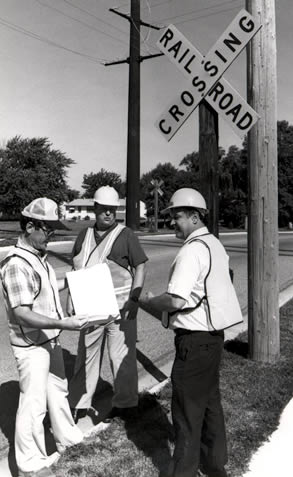
George Thibault (right) on the job in 1992—after a mere 40 years at Mn/DOT. Mn/DOT photo file |
New technology keeps luring ‘retired’ long-time employee back to work
“It ain’t over ‘til it’s over,” Yogi Berra’s famous line, might well describe George Thibault’s philosophy toward work.
Thibault, who started working at Mn/DOT in June 1952 between his junior and senior years in high school, retired officially in September 1997. Although he was used to people good-naturedly pointing out that they weren’t even born when he started working, it was when one young woman told Thibault that her mom hadn’t even been born yet that he figured maybe it was time to retire.
However, four months later, the Office of Transportation, Data and Analysis asked him to come back temporarily to fill in as a supervisor. Every year since then he has returned to the department as a part-time, intermittent employee, thus far serving two stints with the Office of Land Management and another four with the Rail Section of the Office of Freight and Commercial Vehicle Operations.
Currently, Thibault is involved with GIS projects for railroad crossing inventory and project management.
“Keeping in touch with new technology is what’s keeping me around,” said Thibault, whose work tools have evolved during his five decades at Mn/DOT from the graphic pens of the Leroy lettering system to computer-aided design and geographic information systems. “I always tried to be as smart as the new kids.”
Back when he was a new kid himself, Thibault earned $1.13 an hour as a laborer in the Detroit Lakes district. Working on Hwy 34 between Dunvilla and Barnesville that first summer, he shook gravel through a sieve to determine if the material was the right gradation for the job.
The summer of 1953 found him working on the survey crew on Hwy 75 near Georgetown in the Bemidji district.
“We finished that job on a Saturday, and I had to report to Mankato on Monday,” Thibault said. “In the pre-interstate days we didn’t have enough staff, so we were moved around as needed.”
That fall, he enrolled in the civil engineering program at the University of North Dakota —Grand Forks, but returned each summer to work on Mn/DOT road crews.
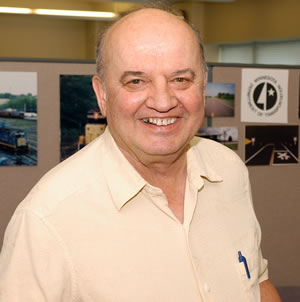
Keeping in touch with new technology is what’s keeping George Thibault, Freight, Railroads and Waterways, around after more than 54 years at Mn/DOT. Photo by David Gonzalez |
In 1955, he took a four-year military leave from Mn/DOT and joined the U.S. Air Force. While Thibault was in Germany, and later Florida, his co-workers back home were beginning to build the interstate highway system, thanks to legislation that President Eisenhower signed in June 1956.
In 1959, near the end of his military service, Thibault wrote to Lee Nelson, then head of Human Resources, who suggested Thibault stop by Central Office when he was home on leave to see about job opportunities. Thibault headed for 1246 University Ave. in St. Paul and found that the Central Office had moved to a new location—the current Transportation Building on the Capitol mall—during his absence.
Thibault returned to Mn/DOT that fall to work in the Traffic Engineering unit, drafting freeway signs, and was responsible for the first draft of the traffic engineering manual.
From 1960-75, he was involved with the right of way acquisition process for many interstate projects, including the Interstate 94 corridor through Minneapolis and St Paul.
“This involved laying out right of way to cover the construction limits of the projects, determining property locations based on abstracts of title, preparing the legal descriptions, measuring and photographing the buildings, and drafting the floor plans of the buildings to be acquired,” Thibault said. This information was included in the property appraisals to determine the state’s offer.
Thibault, who has worked under all of the department’s 16 commissioners except the first two, noted that Mn/DOT is a good recruiting ground for student workers—“not only for starting a career, but having a good long career here,” he said.
“The advice I would give any current or future employee would be to find out how what you do fits into the overall department picture,” he said. "Stick with a job long enough to learn how to do it well, then move on to some other area and do the same thing."
As for when Thibault might “retire” again, he said it may be the day someone tells him that 1952 was before their grandmother was born.
Practical advice led two Metro District employees to 50-year careers
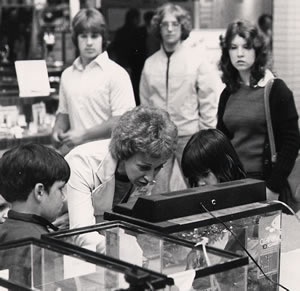
Darlene Lazer demonstrates a water quality testing exhibit during a 1978 Transportation Days celebration at the Rosedale Mall in Roseville. Mn/DOT file photo
|
Jack Pirkl and Darlene Lazer have both logged 50 years of service with Mn/DOT. They credit some advice they received on their first days on the job for their long, rewarding careers.
For Pirkl, the advice was “Follow Harry.”
In 1955, after being dropped off by his father at a resident office in Maplewood, Pirkl asked “office man” Don Roberts what he should do.
“Follow Harry,” Roberts told Pirkl as he gestured toward Harry Smith, a veteran bridge inspector.
Smith took the 18-year-old Cretin High School graduate in tow. He taught Pirkl the basics of bridge construction and inspection, launching his career with Mn/DOT.
Lazer moved to St. Paul in 1956 from Lanesboro just after graduating from high school to seek employment.
Lazer, then 17, stayed with an aunt in St. Paul. The aunt told her if she were offered employment with the Drivers’ License Bureau to turn it down because it was a “boring, dead-end job.”
A few days later, Lazer passed the state’s typing and stenography tests, and was informed there was an immediate vacancy in the license bureau.
The tiny (4’-11”, 98 pounds) but feisty Lazer told a human resources manager, “Oh, but my aunt says I can’t work there.”
Impressed with Lazer’s directness, the manager told her there was also an opening with the Department of Highways for a stenographer.
She accepted, then walked from the State Office Building to 1246 University Avenue to begin her career with Mn/DOT.
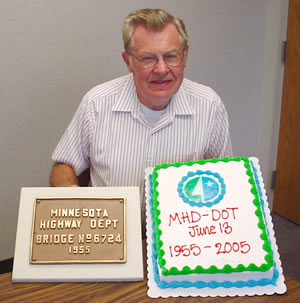
Jack Pirkl posed for this photo when he acquired the bridge plate from his first project after the bridge at Hwy 36 and Dale Street in Roseville was demolished in 1999. Photo courtesy of Jack Pirkl |
Both of their careers advanced quickly from those early days.
Pirkl worked on other bridge projects including two on the University of Minnesota’s main campus and the first Wakota Bridge that carried Hwy 100 across the Mississippi River.
He also worked on survey crews and projects such as building the “Mother Lake” interchange that joined Hwy 62 and Cedar Avenue in Richfield.
Pirkl’s expertise grew; in 1971 he earned registration as a professional engineer. He worked on the highly controversial Interstate 35E project in St. Paul and led construction of the concrete median barrier that separates traffic on I-94 in Minneapolis and St. Paul.
In 1974, Pirkl switched from construction to maintenance operations.
“I was happy to use the spec book as a reference and not as a bible,” he said.
Lazer progressed through a series of administrative jobs with increasing responsibility. After working at the old headquarters building on University Avenue and in the Central Office, Lazer moved to the then new District 9 offices in Oakdale. She supervised the front desk staff and the file room.
Kermit McRae, a former district engineer, chose Lazer as his administrative assistant and expanded her roles and responsibilities. She worked with McRae and 11 other district engineers in the former Oakdale District and the Metro District.
While working with Mn/DOT, Lazer also led efforts to achieve recognition for office administrative assistants as professionals and their role in an organization’s success.
She earned recognition for herself as well, being cited several times for ability, leadership and focus on customer service.
Lazer has served as the top administrative aide with the Metro District since it was established in 1989 and inspired four generations of Mn/DOT employees with her loyalty, competence and outgoing personality.
Lazer and Pirkl both embrace change, but they also lament the passing of a time when the rules were looser and the people were closer.
“We had a more family kind of atmosphere at work,” Lazer said. “We worked and played together, but we knew our boundaries and respected them.”
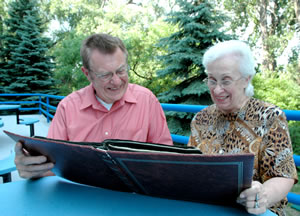
The Metro District’s Jack Pirkl and Darlene Lazer look over one of Lazer’s photo scrapbooks at the district’s headquarters building in Roseville. Photo by Craig Wilkins
|
Lazer said she once made and wore a bright orange hot pants outfit to persuade Joe Clancy, a much-loved but very shy building maintenance worker, to attend a 1971 retirement party in his honor.
“His wife told me that’s what it would take to get him there, so that’s what I did,” she said.
During the early parts of his career, Pirkl said decision-making was frequently done in the field, often by intuition, and that staff and contractors often shared a round of beers on Friday afternoons to relax after a hard week’s work.
Pirkl also said that field staff occasionally purchased materials or contractors’ work before the funds were officially made available to pay them in order to keep their projects on schedule.
“We got caught a few times, but there were a lot fewer auditors back then,” he said.
|



